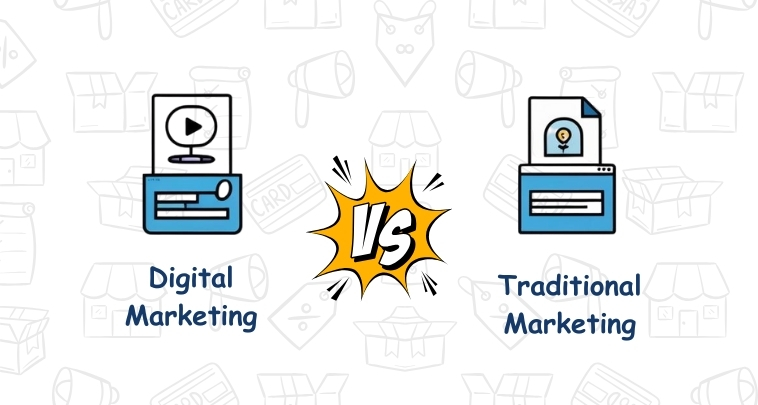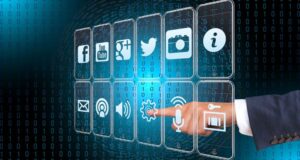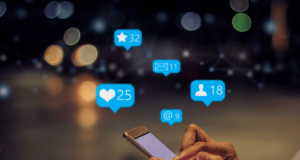1. Introduction
Marketing has come a long way from the days of newspaper ads and TV commercials. In 2025, businesses have two major marketing approaches: digital marketing and traditional marketing. While both have their own merits, the shift in consumer behavior and technological advancements have drastically changed the way companies reach their audience.
With the rise of artificial intelligence (AI), automation, and personalization, digital marketing is leading the way. However, traditional marketing still holds value, especially for local businesses and high-impact branding campaigns. This article dives deep into the battle between digital and traditional marketing in 2025, highlighting their differences, benefits, challenges, and future trends.
2. What is Digital Marketing?
Definition and Key Characteristics
Digital marketing refers to all marketing efforts that use the internet or electronic devices. Businesses leverage online platforms such as social media, search engines, websites, and email to promote their products or services.
Types of Digital Marketing
Some of the key types of digital marketing include:
-
Search Engine Optimization (SEO) – Optimizing content for search engines like Google.
-
Pay-Per-Click Advertising (PPC) – Paid ads on platforms like Google Ads and Facebook Ads.
-
Content Marketing – Creating valuable content like blogs, videos, and infographics.
-
Social Media Marketing – Engaging with audiences on platforms like Instagram, Facebook, and LinkedIn.
-
Email Marketing – Sending promotional emails to potential and existing customers.
-
Affiliate Marketing – Partnering with influencers or websites to promote products.
Why Digital Marketing is Booming
-
People spend more time online than ever before.
-
Businesses can target specific audiences based on interests and behavior.
-
AI and machine learning improve personalization and efficiency.
-
Cost-effective strategies compared to traditional marketing.
3. What is Traditional Marketing?
Definition and Key Characteristics
Traditional marketing refers to offline marketing strategies that existed before the digital revolution. It includes advertising methods such as print media, TV, radio, billboards, and direct mail.
Types of Traditional Marketing
-
Print Advertising – Newspapers, magazines, brochures, and flyers.
-
Broadcast Advertising – TV and radio commercials.
-
Outdoor Advertising – Billboards, posters, and transit ads.
-
Direct Mail Marketing – Sending catalogs, postcards, and letters.
-
Telemarketing – Promotional phone calls to potential customers.
Why Traditional Marketing Still Exists
-
It provides physical and tangible marketing materials.
-
People still trust traditional media over digital ads.
-
It is effective for local businesses and older demographics.
4. Key Differences Between Digital and Traditional Marketing
| Factor | Digital Marketing | Traditional Marketing |
|---|---|---|
| Communication Channels | Online platforms (social media, websites, emails) | Offline media (TV, radio, newspapers) |
| Audience Targeting | Highly targeted (based on behavior, demographics) | Broad targeting (geographic, mass audience) |
| Cost-effectiveness | More affordable for small businesses | Expensive (TV ads, billboards) |
| Measurability & Analytics | Trackable with real-time analytics | Difficult to measure results |
| Engagement | Interactive (comments, likes, shares) | One-way communication |
5. Advantages of Digital Marketing in 2025
-
Cost-Efficiency: Online ads are cheaper than TV and print ads.
-
Global Reach: Businesses can target international audiences.
-
Personalization & Targeting: AI-driven ads cater to specific user interests.
-
Data Analytics & AI: Real-time insights help optimize campaigns.
-
Social Media & Influencer Marketing: Directly engage with customers.
6. Advantages of Traditional Marketing in 2025
-
Tangibility & Credibility: Print materials feel more authentic.
-
Better for Local Businesses: Flyers and billboards work for small communities.
-
High-Impact Branding: TV ads create memorable brand impressions.
-
Longer-Lasting Impressions: A magazine ad can be seen multiple times.
7. The Role of AI and Automation in Marketing
How AI Enhances Digital Marketing
Artificial intelligence (AI) has completely transformed digital marketing in 2025. From chatbots providing instant customer support to AI-driven ad campaigns optimizing themselves in real time, businesses can now automate and personalize their marketing strategies like never before.
AI tools analyze massive amounts of data to predict consumer behavior, improve targeting, and enhance content recommendations. Brands leverage AI-powered chatbots to handle customer inquiries 24/7, improving user experience and engagement. Additionally, AI-driven voice search and smart assistants (like Alexa and Google Assistant) have become major marketing channels.
Automation Tools in Digital Advertising
Automation has made digital marketing more efficient and cost-effective. Some popular automation tools include:
-
Chatbots – AI-powered virtual assistants that interact with customers.
-
Email Automation – Personalized email campaigns based on user behavior.
-
Ad Bidding Automation – AI optimizes ad spend in real time.
-
Social Media Scheduling – Posts are automatically scheduled and optimized for engagement.
AI-Driven Customer Experience
Consumers in 2025 expect fast, personalized experiences. AI helps brands deliver customized content, product recommendations, and customer support without human intervention. Companies that embrace AI-driven marketing strategies gain a competitive edge in reaching and retaining customers.
8. Consumer Behavior Trends in 2025
Shift Towards Online Shopping and E-Commerce
The global e-commerce market continues to dominate retail sales. Consumers prefer shopping online due to convenience, better pricing, and access to a wide range of products. With social media platforms like Instagram, TikTok, and Facebook integrating shopping features, online purchasing is faster and easier than ever.
The Role of Trust and Authenticity
Consumers in 2025 are more skeptical of traditional advertising methods. They prefer brands that focus on authenticity, transparency, and ethical business practices. Influencer marketing and user-generated content (UGC) have gained popularity because people trust recommendations from real customers more than corporate ads.
Changing Attention Spans and Content Consumption
With the rise of short-form content on platforms like TikTok, YouTube Shorts, and Instagram Reels, consumers’ attention spans are decreasing. Brands must create engaging, bite-sized content to capture and retain audience interest. Traditional long-form ads and commercials are losing effectiveness compared to interactive digital content.
9. The Rise of Omnichannel Marketing
Blending Digital and Traditional Marketing
Successful businesses in 2025 do not rely solely on digital or traditional marketing—they use an omnichannel approach. This means integrating multiple channels (online and offline) to provide a seamless customer experience.
For example, a brand may:
-
Use social media ads to generate interest.
-
Send email promotions to nurture leads.
-
Advertise on TV or radio for brand credibility.
-
Use in-store promotions for physical engagement.
Importance of a Unified Marketing Strategy
An effective omnichannel strategy ensures that customers receive a consistent brand message across all touchpoints. Whether a customer interacts with a business via social media, a physical store, or an email campaign, their experience should feel cohesive.
Examples of Successful Omnichannel Marketing
-
Nike – Combines online ads, influencer marketing, retail stores, and mobile apps.
-
Coca-Cola – Uses traditional TV ads alongside social media campaigns and in-store promotions.
-
Amazon – Integrates digital advertising, AI-powered recommendations, and physical stores (Amazon Go).
10. Challenges in Digital Marketing
Privacy Concerns and Data Protection Laws
With stricter data protection regulations like GDPR and CCPA, businesses must be more transparent about how they collect and use customer data. Consumers are becoming more aware of their digital privacy and prefer brands that prioritize data security.
Increasing Competition
The rise of digital marketing has led to oversaturation in online spaces. Businesses must find creative ways to stand out from competitors, whether through unique branding, high-quality content, or innovative advertising strategies.
Ad Fatigue and Consumer Skepticism
People are bombarded with digital ads daily, leading to ad fatigue. Many consumers use ad blockers or simply ignore promotional content. Brands must focus on delivering value-driven and engaging marketing campaigns rather than intrusive ads.
11. Challenges in Traditional Marketing
High Costs and Limited Reach
Compared to digital marketing, traditional marketing methods (TV, print, and radio) require a larger budget. Running national TV commercials or placing billboards can be costly, making it less accessible for small businesses.
Difficulty in Tracking ROI
One of the biggest drawbacks of traditional marketing is the inability to track results accurately. Unlike digital marketing, which provides real-time analytics, traditional marketing relies on estimates and indirect measurements of success.
Declining Print and TV Viewership
Newspapers, magazines, and TV channels have seen a decline in audience numbers as people shift towards digital content consumption. Streaming services, podcasts, and social media platforms have overtaken traditional media as primary sources of information and entertainment.
12. Case Studies: Digital vs. Traditional Marketing Success Stories
Example of a Brand Succeeding with Digital Marketing
Glossier – A beauty brand that built its success entirely through social media and influencer marketing. By leveraging user-generated content and Instagram advertising, Glossier created a loyal online community without relying on traditional marketing.
Example of a Brand Benefiting from Traditional Marketing
Coca-Cola – Despite the dominance of digital marketing, Coca-Cola still invests heavily in traditional TV commercials, billboards, and sponsorships. Their Super Bowl ads and holiday campaigns continue to create lasting brand impressions.
13. Future of Marketing: Predictions for 2030
Expected Trends in Digital Marketing
-
AI-generated content and hyper-personalization.
-
Virtual reality (VR) and augmented reality (AR) marketing experiences.
-
Voice search optimization for smart assistants.
Evolution of Traditional Marketing
-
Increased integration with digital platforms (e.g., QR codes on billboards).
-
More experiential marketing strategies (interactive events and pop-ups).
-
Niche targeting in print media and direct mail campaigns.
The Potential of Hybrid Marketing Strategies
Rather than choosing between digital or traditional marketing, businesses in 2030 will focus on hybrid strategies, combining the best of both worlds for maximum impact.
14. Which Marketing Approach is Better for Your Business?
Factors to Consider When Choosing a Strategy
-
Budget – Digital marketing is more cost-effective.
-
Target Audience – Traditional marketing works well for older demographics.
-
Business Type – E-commerce brands thrive with digital marketing, while local businesses may benefit from traditional methods.
Small Business vs. Large Corporations
-
Small businesses should prioritize digital marketing due to affordability and precise targeting.
-
Large corporations can afford a mix of digital and traditional marketing for a broader reach.
Industry-Specific Considerations
-
Retail and fashion: Digital marketing (social media and influencer marketing).
-
Automotive and real estate: Traditional marketing (billboards and TV ads).
-
Tech startups: Digital-first approach (SEO, PPC, and content marketing).
15. Conclusion
Both digital and traditional marketing have their unique strengths and challenges in 2025. While digital marketing offers cost-effective, data-driven solutions with global reach, traditional marketing provides credibility and high-impact branding.
For businesses looking to maximize their marketing efforts, an omnichannel approach—integrating digital and traditional marketing—proves to be the most effective strategy. As technology evolves, staying ahead of marketing trends and adapting to consumer behavior will be key to business success.



